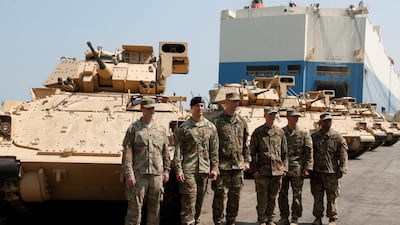Lebanon this week became the second country in the world to receive delivery of US-made Bradley armoured personnel carriers.
“The transfer of M2A2 Bradleys to Lebanon reflects the level of trust that the US has in the LAF [Lebanese Armed Forces] as a responsible regional partner in the broader counter-ISIL effort,” said Aram Nerguizian, a senior associate with the Burke Chair in Strategy at the Centre for Strategic and International Studies in Washington.
Saudi Arabia was the only country outside the US that had the M2A2 in its inventory.
The Bradley holds seven soldiers in addition to a gunner, commander and driver, and counts as a “major combat system”, Mr Nerguizian said.
Last year, Israeli officials claimed Hizbollah had acquired US-made armoured vehicles from the Lebanese army after the Shiite group showed off M113 armoured personnel carriers during a military parade in Qusayr, a Syrian city it captured in 2013. The US, Arab League and the GCC consider the Lebanese movement a terrorist organisation.
The Pentagon responded by saying that the likely source of the vehicles was actually the South Lebanon Army, a proxy force supported by Israel during the Lebanese civil war. Israel also has M113s in its arsenal.
“They would not have transferred the Bradleys if they had any real concerns about end-use monitoring, or if they echoed the concerns of some LAF weapons possibly falling in the hands of Hizbollah,” Mr Nerguizian said.
He pointed out that instead of focusing on concerns that weapons were used by groups other than the army, the US has been ready to transfer other advanced equipment to Lebanon for some time, but lack of funding and planning had stalled their delivery.
_________________
Read more:
Lebanon army hit back at ISIL positions after extremists fired artillery that landed in town
Hizbollah chief says ready to battle ISIL on Lebanon-Syria border
_________________
When Saudi Arabia in 2015 appeared to commit funding for the LAF to acquire weapons systems, "the possible provision of M1A1 main battle tanks to the LAF was actively considered, and then planned for, right up until KSA suspended their grant funding to the LAF in early 2016”, he said.
On Thursday, a Lebanese military spokesman confirmed the vehicles would not be ready for use in the pending offensive against ISIL, adding that the US would provide training and maintenance for the vehicles.
His comments came as the Lebanese army continued shelling ISIL positions in northern Lebanon ahead of the start of a new offensive against the group there, though it remains unclear when the operation might begin.
On Wednesday, the army moved to further surround ISIL’s positions in the area after about 3,000 Syrian fighters and refugees left the area and returned to Syria.
The army this week also reportedly took over nearby positions that were captured by Hizbollah last month from an Al Qaeda-affiliated militant group.
“Over the last few years, as you know, the United States has intensified its engagement and support to the Lebanese army,” the US ambassador to Lebanon, Elizabeth Richard, said at a ceremony marking the delivery of the Bradleys.
The delivery of the Bradleys “represents an investment of over US$100 million [Dh367m]. It will provide the Lebanese Armed Forces with new capabilities to protect Lebanon, to protect its borders, and to fight terrorists.”
She also highlighted the support the Lebanese army has received from the US in the past year, including heavy artillery, armoured Humvees and aircraft armed with missiles.
Lebanon has received more than $1 billion in US military aid in the last 10 years, though Hizbollah’s closeness to the government has led some American lawmakers to call for cuts to such assistance.
The US state department has suggested that Washington could halt its military aid to Lebanon next year, although some analysts have said such a drastic move seems unlikely after prime minister Saad Hariri’s visit to Washington earlier this month.
Others are less sure.
“Regardless of whether the White House wants [funding to continue] after its meeting with Hariri, Congress is going to have a say. I think there are many in Congress who are concerned about the ongoing collaboration between the LAF and Hizbollah,” said David Schenker, a former Pentagon official and the director of the programme on Arab Politics at the Washington Institute for Near East Policy.
“It is essentially illegal for organisations that receive money from the US to cooperate with a terrorist organisation,” Mr Schenker said.
“There are many conservatives who say that essentially even as US financial assistance has increased, the government has become more aligned with Hizbollah. But I think the potential benefits marginally outweigh the downside.”
Fears of weapons “leakage” in the region are not unfounded. US-provided weapons have fallen into the hands of a number of non-state actors in the region recent years, particularly ISIL, Iraq’s Popular Mobilisation Forces, the YPG Kurdish militia in Syria and Yemen's Houthi rebels.
On Thursday, a Facebook page posted a video of what appeared to be a US-allied militia in Syria firing a US-made anti-tank rocket against Turkish forces.
It was unclear whether the rocket had been supplied directly by the US, though Jeish Al Thuwar, the faction that posted the video, is a member of the Syrian Democratic Forces, which receive US training and weapons.

